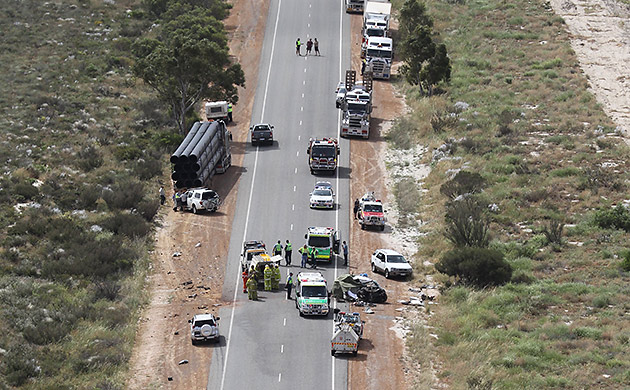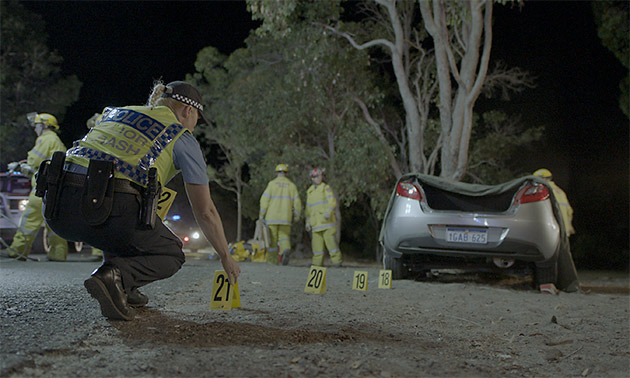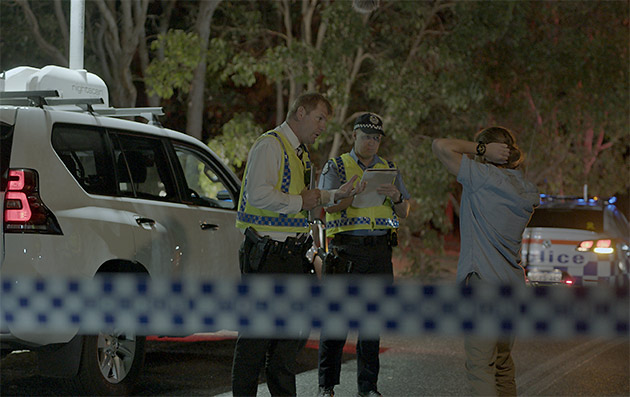20 January, 2020 By: Vanessa Pogorelic
How road crash investigators go back in time to reconstruct the point of impact.
It was one of Western Australia’s most complex onsite crash investigations in recent years - a crash scene that stretched for two kilometres with vital evidence spread across three freeway lanes during heavy peak-hour traffic.
The multi-vehicle crash on Kwinana Freeway on 2 October 2019, brought the city to a standstill.
A multitude of difficult traffic conditions and a tragic incident collided on that day to create chaos on Perth roads.
“It was the perfect storm,” says Detective Sergeant Travis Hagan of the WA Police Major Crash Investigation Section.
“In terms of our ability to get to the scene it was the worst spot for it to happen and at the worst time.”
Regardless of the logistical difficulties and the impact of road and lane closures on other drivers, there was a fatality and important clues about what happened scattered over a massive area that needed to be inspected, scanned and investigated by the Major Crash team.
When a crash scene becomes a crime scene
In WA, the Major Crash Investigation team are tasked with assessing any vehicle crash in the State that involves a death or serious injury to another person, where the driver may be culpable.
“A lot of what we deal with are criminal offences. It could be manslaughter, or it could be a deliberate act, so it falls possibly into a homicide area. Or it could just be a horrible accident, but a person is still culpable under the road traffic legislation,” explains Detective Senior Sargent Mal Jones from the team.

When a crash occurs, local police attend and provide an update at the scene, gathering all available information. An assessment is then made as to whether Major Crash should be called out.
“Once we’ve identified we’ve got serious injuries, we suspect we’ve got a culpable driver, or in fact we’ve got a fatality, Major Crash will start our deployment process,” Jones says.
When gathering evidence for a case that may go to Supreme Court level, ensuring a thorough investigation is made of an entire crash scene is critical, regardless of the conditions and terrain.
Crash investigators work with two other teams of experts: The Vehicle Investigation Unit, who provide technical and mechanical assessments of the vehicles involved, and crash reconstruction officers. It is the reconstruction officers whose job it is to search the crash scene and find every piece of evidence, big or small, that can be used to reconstruct the moment of impact.

“They’ll go out and examine the scene and mark it for anything left behind which may be of interest. They also plot the course of the vehicle or vehicles involved. And they’ll then assess if someone’s acts have been careless or dangerous resulting in injury and or death,” Travis Hagan says.
Even where a lightbulb lands can mean a lot
The force of many crashes can scatter evidence across a wide area. An impact at high speed can see debris from one vehicle land up to 200m away. “There was an instance where two vehicles crashed and ended up 190 metres apart from each other, with debris from each one spread even further from there,” Hagan says.
Even minor details can provide a significant insight into what happened, which is why the full length and breadth of each scene must be marked out and closely inspected.
“Reconstruction officers examine every object that may have come into contact with the vehicles involved – even paint transfer from another car tells them a lot, or where a light bulb or bumper was located
“You might see skid marks going towards a crash scene and they may curve in a particular direction and that may be a tell-tale sign that a brake on one side of the vehicle isn’t working so it pulls left or right, or it might be indicative of a steering issue,” Hagan says.
In any major crash investigation, the site should be inspected soon after the crash to prevent evidence being disturbed or moved.
In the case of the Kwinana Freeway closure on 2 October last year, it took approximately five hours for the scene to be cleared sufficiently for Major Crash to begin their work due to the build-up of traffic.
“We had some people who couldn’t reverse their vehicle. We had trailers who couldn’t reverse. You couldn’t turn them around, they were too big. Police officers had to back some of the trailers out -some up to a couple of kilometres.”
After a scene is cleared of traffic, in order to record all details at the site, reconstruction officers will deploy a drone to take aerial images and use a laser scanning device at ground level.

“The laser will scan the area and take computer imagery that can be rendered into a 3D image. We can then present a digital model of the scene in court if needed.”
Once the scene is scanned and inspected, vehicles are then seized and removed and vehicle investigators undertake an inspection, assessing the damage and checking for any mechanical or technical faults that may have contributed to the crash.
Cracking a car’s computer systems to see into the past
Data contained in a vehicle’s on-board computers is becoming invaluable for crash investigators.
“Our crash reconstruction officers download data from vehicles and that gives us really useful information. It will tell us about what sort of driver input was occurring prior to the crash. It’ll tell us the acceleration, the braking, what gear it was in, steering inputs, whether cruise control was active,” Hagan says.
CCTV and dashcam footage from other vehicles can also be used to backup witness accounts and provide evidence of exactly what occurred at a crash scene.
Once data and evidence from all sources and teams involved in an investigation has been gathered, it is analysed to build a picture of what happened at the moment the crash occurred.
All that science versus a guilty conscience
With more than 150 fatalities on WA roads last year and many more crashes involving serious injuries, crash investigators are regularly at work across Perth and around the State, gathering and evaluating evidence and preparing for court cases.
An enormous number of people from many agencies will become involved, from first responders attending the scene, to the crash team tasked with the subsequent investigation.
But Mal Jones says that sometimes, there can be something even more powerful at play than all the data, technology and forensic processes, that determines the end result.

“People have a conscience and sometimes they just need to cleanse their soul. Someone might come forward and say they want to confess to clear their conscience.
“We had a gentleman present at a Police station just a few months ago and he confessed to a crash that happened about 10 years ago.
“We still have unsolved investigations, like unsolved hit and runs. But new information may come in and we’ll reopen the file.”
Jones says some cases are resolved quickly while others may take many years to finally close.
But for those personally affected by a major crash, the consequences of what happens in a split second on the road, will continue to reach far beyond the point of impact.
Be a witness
If you’ve witnessed a crash and have images, CCTV or dashcam footage of the incident, you can supply them to WA Police as evidence. Follow the links from the WA Police Facebook or X accounts. Images and video footage can be uploaded from a mobile phone.
If you are a witness to a crash always make safety a priority at the scene.
Some images featured in this story show Major Crash Investigation Officers filmed as part of a crash re-enactment, commissioned by RAC.
